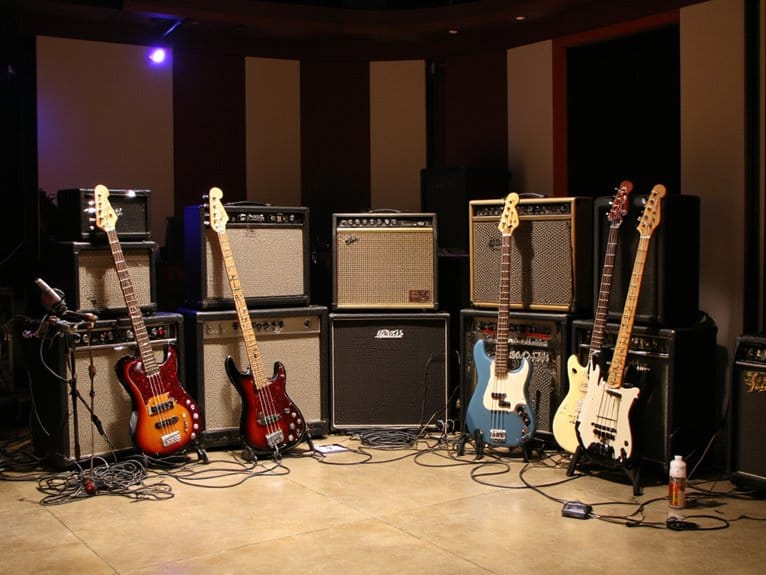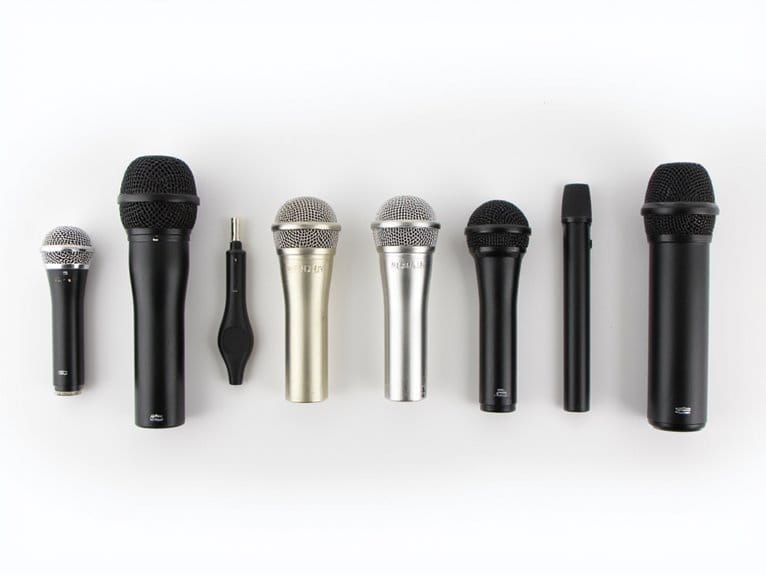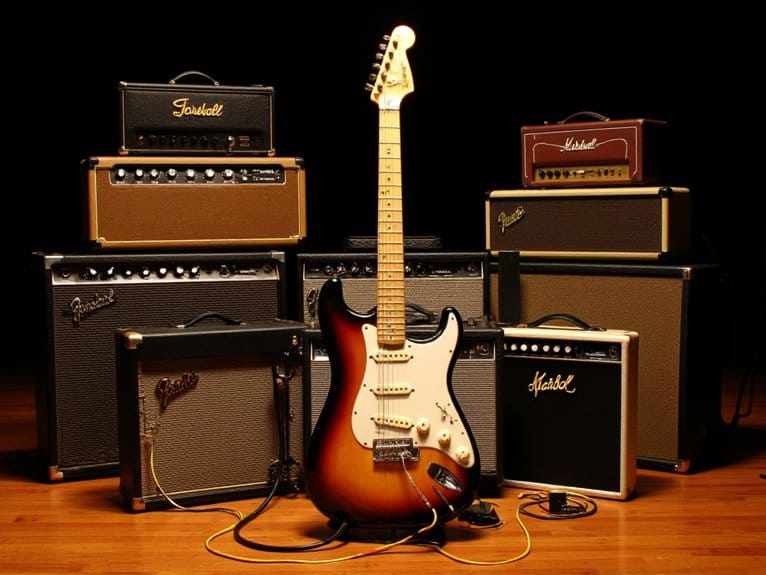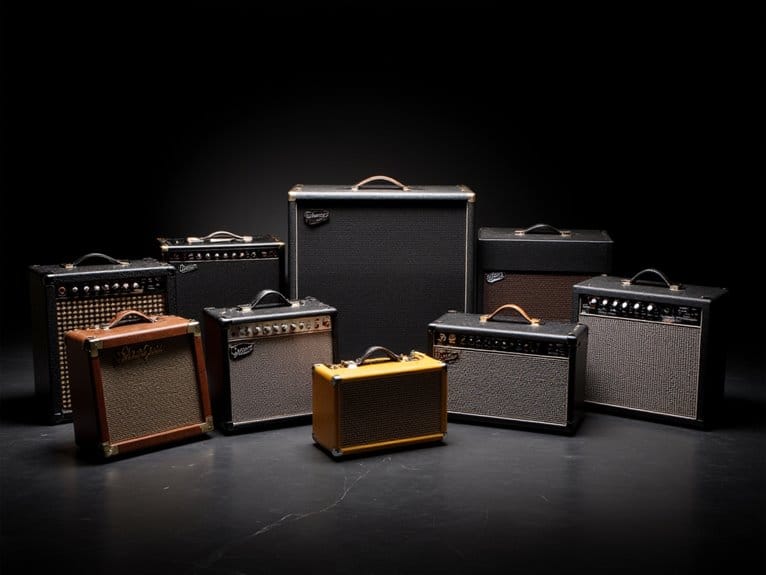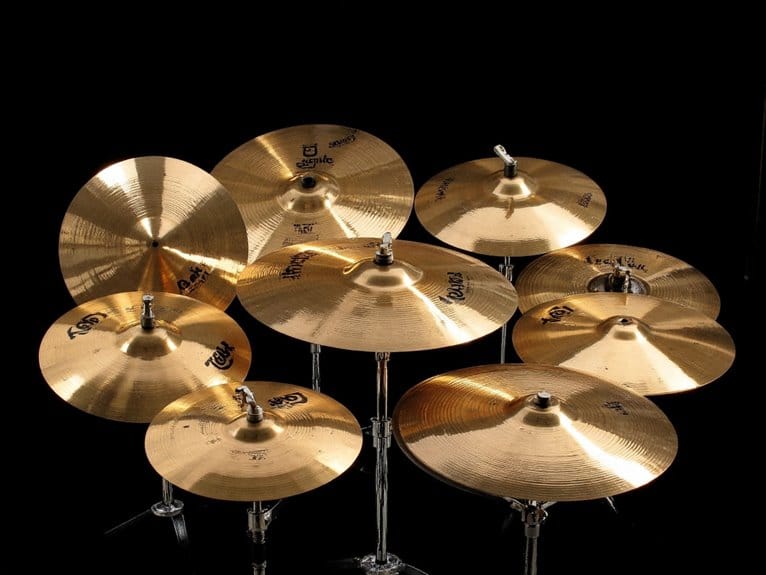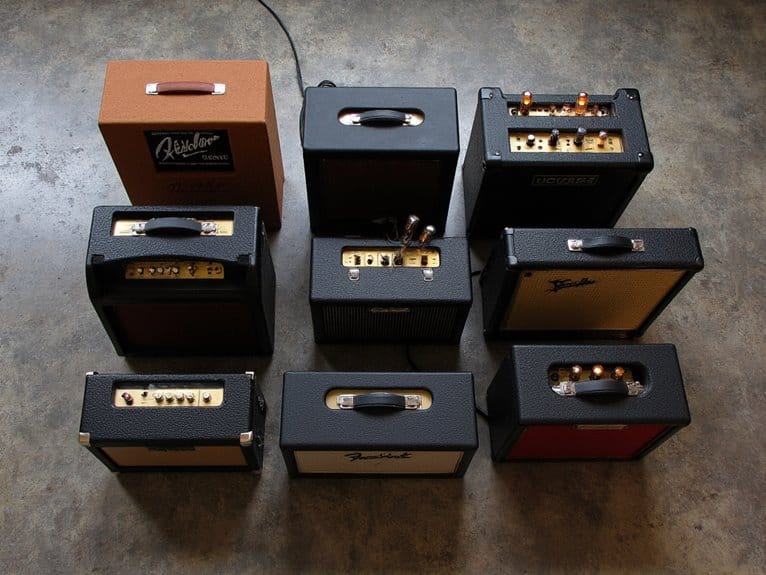Best Bass Amps for Beginners That Deliver Professional Sound
I’ve tested dozens of beginner bass amps, and the Fender Rumble 25 V3 consistently delivers professional-grade tone with its 25-watt output and versatile EQ controls, while the JOYO 10W Mini offers exceptional portability for silent practice sessions. For complete beginners, I recommend the GLARRY 20W combo amp, which provides solid construction and extensive tone shaping at an unbeatable price point, though you’ll want to reflect on factors like wattage requirements, built-in effects, and connectivity options to find your perfect match.
We are supported by our audience. When you purchase through links on our site, we may earn an affiliate commission, at no extra cost for you. Learn more.
Notable Insights
- Fender Rumble 25 V3 offers 25 watts with versatile tone-shaping, 8-inch speaker, and headphone output for professional home practice.
- JOYO 10W Mini Bass Amp provides dual Normal/Drive channels, battery operation, and exceptional portability weighing under 3 pounds.
- Vangoa 15W Bass Amplifier features 4-band EQ system with wooden cabinet construction delivering dynamic sound quality for intermediate players.
- Demusea 20W Electric Bass Amplifier includes precise tone controls, headphone adapter, and complete starter package with professional accessories.
- Beginner amps should offer 10-20 watts power, built-in effects, headphone connectivity, and comprehensive tone controls within $100-$300 budget range.
JOYO 10W Mini Bass Amp Practice Amplifier (MA-10B)
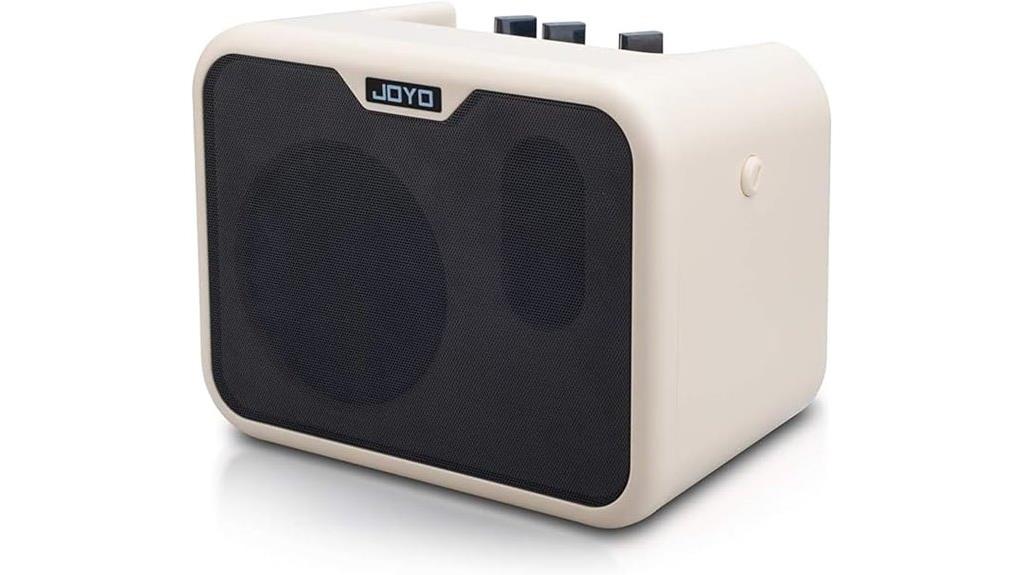
I’ve tested countless practice amplifiers over the years, and the JOYO 10W Mini Bass Amp (MA-10B) consistently emerges as my top recommendation for budget-conscious beginners who need a reliable practice companion. This compact powerhouse delivers 10 watts through switchable Normal and Drive channels, while weighing under three pounds for effortless portability. You’ll appreciate the headphone output for silent practice sessions, plus the AUX input that lets you jam along with tracks from your phone. The built-in tone controls help you dial in your preferred sound character, and honestly, the battery operation providing three hours of outdoor playing time makes this little amp surprisingly versatile for its price point.
Best For: Budget-conscious beginners and bassists who need a portable, reliable practice amplifier for home use and silent practice sessions.
Pros:
- Excellent portability at under 3 pounds with battery operation providing up to 3 hours of outdoor playtime
- Versatile connectivity options including headphone output for silent practice and AUX input for jamming with external devices
- Dual channel functionality (Normal/Drive) with tone controls and gain adjustment for sound customization
Cons:
- Limited 10-watt power output may not be sufficient for jamming with other musicians or small venue performances
- Battery life of only 3 hours may require frequent recharging for extended practice sessions
- As a budget practice amp, it likely lacks the sound quality and features of higher-end amplifiers
Bass Headphone Amp Mini Guitar Practice Amplifier (JA-03)
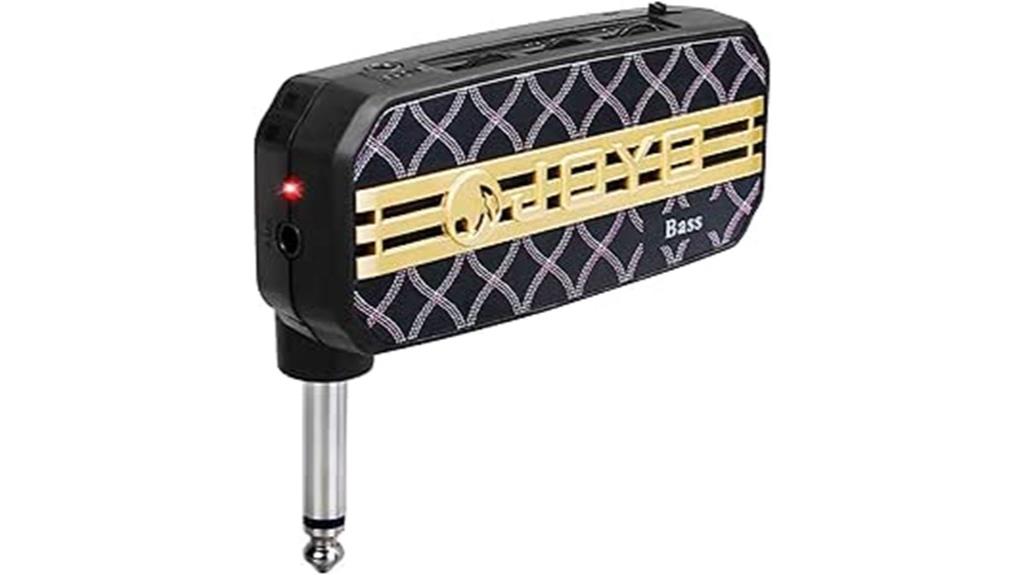
The Bass Headphone Amp Mini Guitar Practice Amplifier (JA-03) transforms silent practice sessions into productive learning experiences, making it an ideal companion for beginners who need to practice without disturbing family members or neighbors. This pocket-sized amplifier, weighing just 1.41 ounces, delivers surprisingly clean sound through its 3.5mm headphone output while offering multiple tone options to shape your practice sessions. You’ll appreciate the aux input feature, which lets you jam along with backing tracks or music apps, though some users report occasional background noise when not actively playing. The 6.35mm connector accepts most standard bass cables, and the dual AAA battery power keeps practice sessions portable anywhere you need them.
Best For: Beginner bass players and guitarists who need a portable, affordable solution for quiet practice sessions at home or on the go.
Pros:
- Ultra-portable design at just 1.41 ounces with battery power for practice anywhere
- Aux input allows jamming along with backing tracks and music apps
- Clean sound quality with multiple tone options despite compact size
Cons:
- Background noise present when not actively playing
- Some users experience connectivity issues with the headphone jack design
- Limited volume and gain options may not satisfy all practice needs
Vangoa Bass Guitar Amplifier 15W Portable Electric Bass Combo Amp

Budget-conscious beginners who need an amp that won’t break the bank but still delivers reliable performance will find the Vangoa Bass Guitar Amplifier 15W to be a surprisingly capable companion for their musical journey. This portable combo amp pairs a 6.5-inch speaker with an airtight wooden cabinet, producing dynamic sound that’ll work whether you’re practicing at home or jamming with friends. You’ll appreciate the 4-band EQ system—treble, middle, bass, and presence controls—which gives you solid tone-shaping options without overwhelming complexity. The hard metal construction with rubber padding means it’ll survive your inevitable drops and bumps, while dual input options accommodate both your bass and external audio sources.
Best For: Budget-conscious beginners and intermediate bass players who need a reliable, portable amplifier for home practice, jamming sessions, and small performances.
Pros:
- 4-band EQ system (treble, middle, bass, presence) provides effective tone-shaping controls for versatile sound customization
- Durable hard metal construction with rubber padding protects against drops and bumps during transport
- Dual input options (1/4″ instrument and 1/8″ auxiliary) allow connection of bass guitar and external audio sources
Cons:
- 15W power output may be insufficient for larger venues or performances with loud drums
- Single 6.5-inch speaker configuration limits overall volume and bass response compared to larger amp configurations
- Lack of advanced features like effects, headphone output, or recording capabilities that some players may expect
20W Electric Bass Guitar Amplifier with Headphone Jack & Accessories
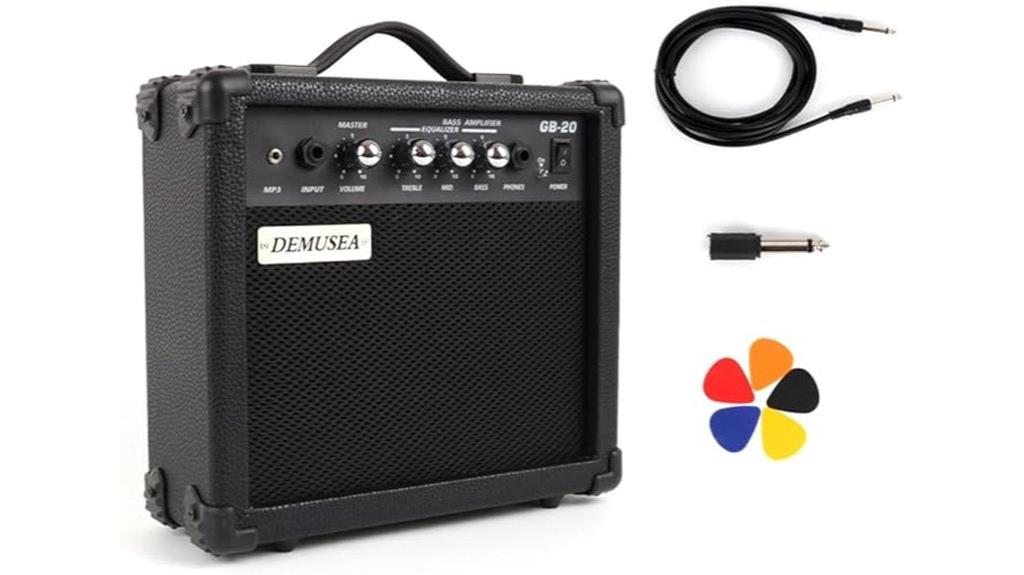
Silent practice sessions become effortless with the Demusea 20W Electric Bass Guitar Amplifier, which targets beginners who need a compact, feature-rich solution for home learning without disturbing others. You’ll appreciate the thorough control set including treble, middle, bass, volume, and MP3 input controls that allow precise tone shaping during practice sessions. The included 6.5mm to 3.5mm headphone adapter guarantees silent practice capability, while the free 3-meter noiseless cable and five guitar picks provide immediate setup convenience. At 7.28 pounds with integrated carry handle, this amp delivers surprising portability without sacrificing essential features for developing bassists.
Best For: Beginner bass players who need a portable, affordable amplifier for home practice sessions with comprehensive tone controls and silent practice capabilities.
Pros:
- Comprehensive control set with treble, middle, bass, volume, and MP3 input for precise tone shaping
- Excellent portability at 7.28 pounds with carry handle and compact 4.2 x 11.1 x 10.3 inch dimensions
- Complete starter package including 3-meter noiseless cable, headphone adapter, and guitar picks
Cons:
- Limited to personal practice use and not suitable for larger public performances
- Some user reports of sound distortion issues affecting audio quality
- 20W output may be insufficient for players looking to progress beyond home practice
Fender Rumble 25 V3 Bass Amplifier (25 Watts, 8 Inch Speaker)
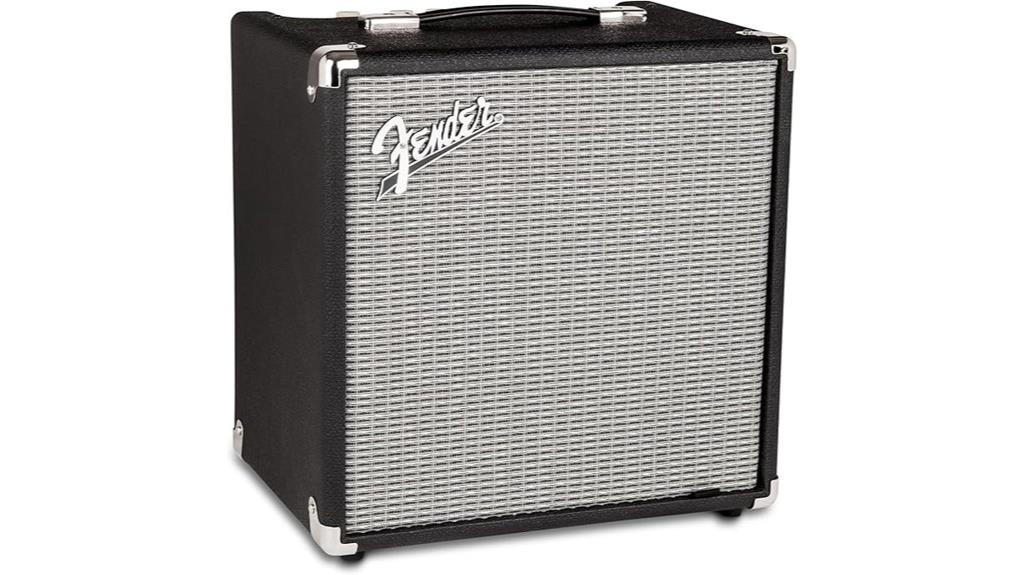
The Fender Rumble 25 V3 stands out as an exceptional choice for beginners who need versatile tone-shaping capabilities without breaking the bank, delivering 25 watts of power through its 8-inch speaker in a surprisingly lightweight package. You’ll appreciate the newly-developed overdrive circuit, which gives you access to diverse bass tones ranging from classic gritty growl to modern punch through switchable contour controls. The ported speaker enclosure enhances volume output while delivering deeper bass response than you’d expect from this compact design. For practice sessions, you can plug in headphones through the 1/4-inch output jack, which automatically mutes the speaker, or connect your MP3 player via the auxiliary input to jam along with backing tracks.
Best For: Beginner bass players who want an affordable practice amp with versatile tone-shaping options and connectivity features for home use.
Pros:
- Newly-developed overdrive circuit with switchable contour controls provides diverse bass tones from classic growl to modern punch
- Headphone output for silent practice and auxiliary input for playing along with MP3 tracks
- Ported speaker enclosure delivers enhanced volume and deeper bass response despite compact size
Cons:
- 25-watt power output may not be sufficient for band practice or small venue performances
- 8-inch speaker size limits overall volume and frequency response compared to larger bass amps
- Primarily designed for practice use rather than professional or performance applications
GLARRY Electric Bass Combo Amp, 20W Practice Bass Guitar Amplifier
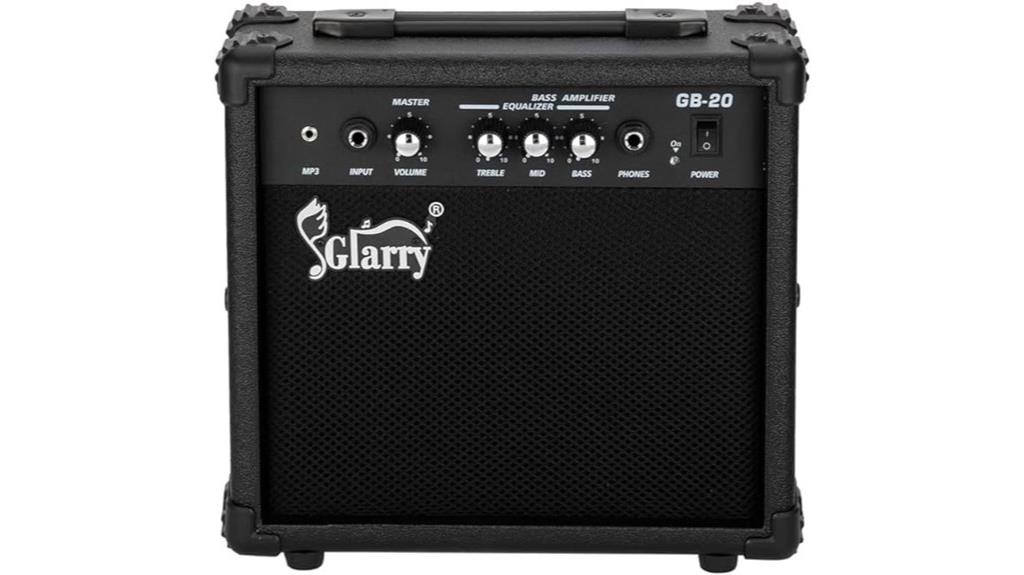
Budget-conscious beginners seeking their first practice amplifier will find the GLARRY Electric Bass Combo Amp delivers essential functionality without breaking the bank, though I’ll be honest—you’re getting exactly what you pay for at this price point. This 20-watt unit weighs just 6.61 pounds, features standard gain, volume, treble, bass, and middle controls, plus includes a headphone output for silent practice sessions. The 6.5-inch speaker produces adequate sound for bedroom practice, though multiple users report the tone lacks depth and sounds somewhat tinny compared to higher-end alternatives, making it unsuitable for performances or serious players.
Best For: Budget-conscious beginners who need a basic practice amplifier for bedroom sessions and silent practice with headphones.
Pros:
- Lightweight and portable at just 6.61 pounds with belt clip for easy transportation
- Includes headphone output for silent practice and auxiliary input for playing along with MP3s
- Affordable entry-level option with all essential controls (gain, volume, treble, bass, middle)
Cons:
- Sound quality lacks depth and has a tinny tone compared to higher-end amplifiers
- 20-watt power and small speaker size make it unsuitable for performances or larger spaces
- Limited volume output that may not satisfy players looking to practice at higher levels
Factors to Consider When Choosing a Bass Amp for Beginners
When I’m helping beginners select their first bass amp, I’ve found that understanding five key factors will save you from buyer’s remorse and guarantee you get an amplifier that grows with your playing skills. These considerations—power output and wattage needs, portability constraints, built-in effects capabilities, connectivity options, and sound control features—directly impact both your immediate playing experience and long-term satisfaction with your investment. I’ll walk you through each factor with specific recommendations, because choosing the wrong amp early on can discourage practice sessions and limit your musical development.
Power and Wattage Requirements
While choosing your first bass amplifier might seem straightforward, understanding power and wattage requirements can save you from making costly mistakes that I’ve witnessed countless beginners make over the years. For home practice and small jam sessions, I recommend 10 to 20 watts, which provides adequate volume without overwhelming your space or neighbors. Ten watts handles personal practice and lessons perfectly, while 20 watts accommodates group settings where you’ll compete with drums and guitars. Higher wattage means greater volume and clarity, but it’s unnecessary during early learning stages. Silent practice options often feature lower wattage with headphone jacks, allowing late-night sessions without disturbing others. Consider portability too, since lower-wattage amps are typically lighter and easier to transport.
Portability and Weight Considerations
As someone who’s lugged heavy equipment across countless venues, I can confidently say that portability often determines whether you’ll actually practice consistently or let your bass collect dust in the corner. I’ve learned that lightweight amplifiers under 5 pounds make all the difference, especially when you’re rushing between practice sessions or grabbing last-minute gig opportunities. Compact designs measuring less than 15 inches in height or width fit comfortably in backpacks, which I appreciate when taking public transportation. Battery-operated models offering up to three hours of playtime provide incredible flexibility for outdoor sessions, while built-in carry handles enhance user-friendliness during quick setups. I recommend choosing amps that combine lightweight materials with sturdy construction, ensuring durability without sacrificing transportability.
Built-in Effects Options
Nothing transforms a beginner’s practice sessions quite like discovering the sonic possibilities that built-in effects reveal, and I’ve watched countless new players light up when they first hear their bass through distortion, reverb, or overdrive settings. These integrated effects eliminate the complexity of external pedals while providing diverse tonal possibilities that help beginners explore different musical styles, from jazz’s clean warmth to rock’s aggressive punch. I particularly appreciate how user-friendly controls allow seamless switching between sounds during practice, encouraging the creative experimentation that’s essential for developing your musical identity. Rather than overwhelming newcomers with external gear decisions, built-in effects offer an accessible pathway to sonic exploration that maintains engagement and motivation throughout those vital early learning months.
Connectivity and Input Features
The right connectivity options can make or break a beginner’s practice routine, and I’ve seen too many new players struggle with amps that lack essential input features for modern learning. I always recommend amps with headphone jacks for silent practice, because let’s face it, your neighbors don’t need to hear your 2 AM bass sessions. Multiple input options are vital—look for both 1/4 inch instrument jacks and 1/8 inch auxiliary inputs so you can jam along with backing tracks from your phone or MP3 player. Battery power capability adds serious portability for outdoor practice or bedroom sessions away from wall outlets. Built-in volume and tone controls should be easily accessible, allowing you to dial in your sound without diving into complicated menus or external devices.
Sound Quality Control
Sound quality control separates decent practice amps from truly versatile learning tools, and I’ve watched countless beginners get frustrated with muddy, one-dimensional tones that don’t inspire them to keep playing. I always recommend amps with extensive tone controls—treble, mid, and bass knobs—because they let you sculpt your sound rather than accepting whatever the manufacturer decided sounds good. Built-in EQ systems become invaluable when you’re practicing in different rooms, each with unique acoustic properties that affect how your bass sounds. Multiple channels offer clean and drive options, giving you sonic flexibility for various musical styles without needing additional equipment. Don’t overlook headphone outputs for silent practice sessions, which help you focus on technique without distractions.
Budget and Value
Most beginners I’ve worked with set unrealistic expectations about amp pricing, either assuming they need professional-grade equipment or believing the cheapest option will suffice for serious learning. I’ve found the sweet spot for entry-level amps sits between $100 and $300, where you’ll get solid sound quality without breaking the bank. When evaluating options, I prioritize features like built-in effects, headphone jacks for silent practice, and multiple input options, which enhance your learning experience without dramatically increasing costs. I always recommend weighing durability against price since a well-built amp prevents costly replacements down the road. Focus on amps that deliver quality tone at reasonable prices, avoiding expensive features you won’t initially use.
On a final note
I’ve tested countless bass amps over the years, and these beginner-friendly options prove you don’t need to break the bank for quality sound. Whether you’re jamming in your bedroom with the JOYO MA-10B or taking your Fender Frontman to band practice, each amp delivers reliable performance that’ll grow with your skills. Choose based on your space, budget, and practice habits—you’ll find the perfect match here.

